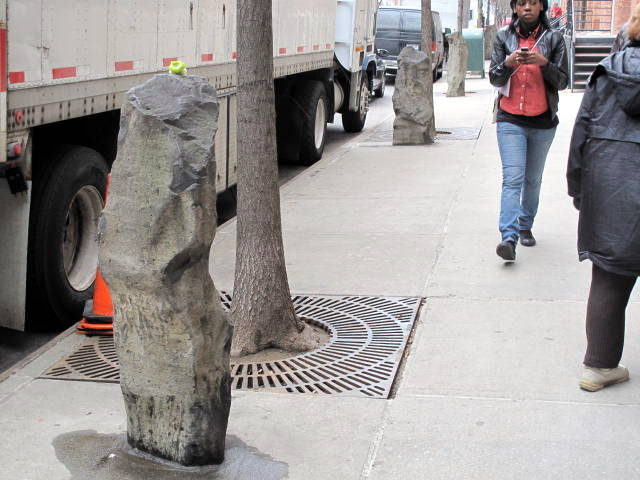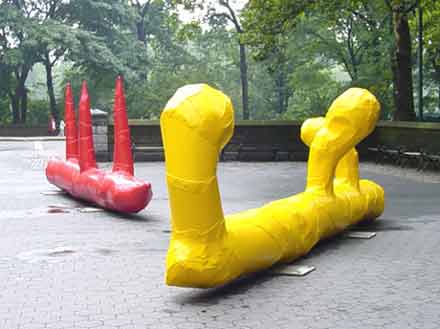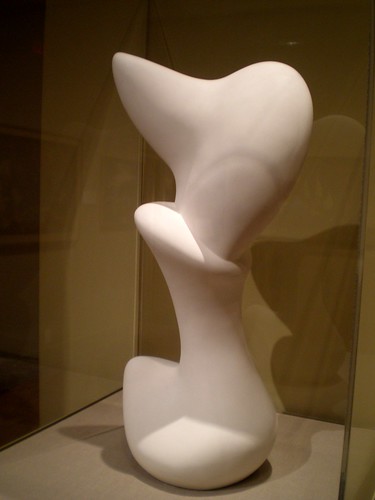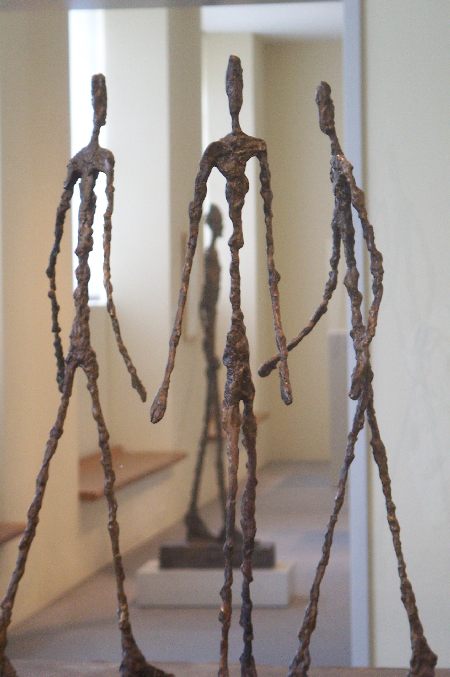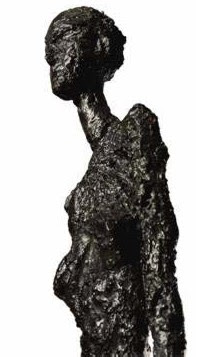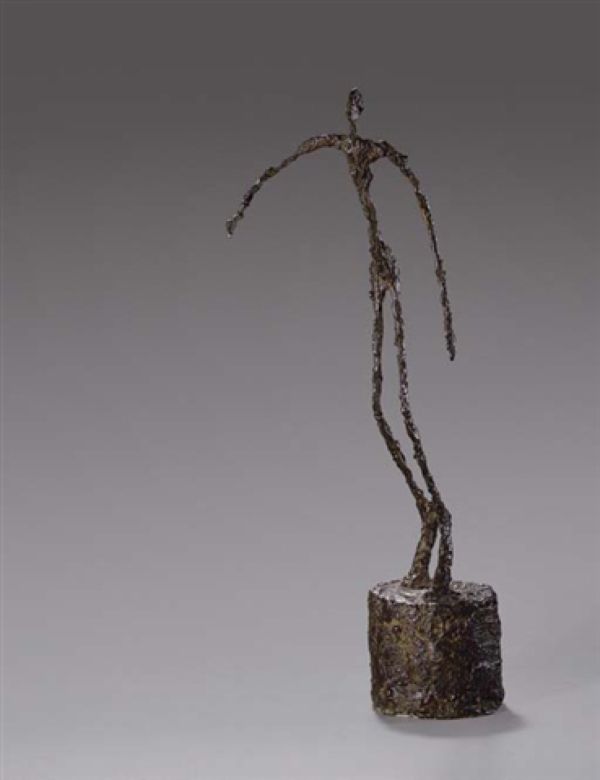From "The War of Art" by Steven Pressfield
1. WHAT I DO
I get up, take a shower, have breakfast. I read the paper, brush my teeth. If I have phone calls to make, I make them. I've got my coffee now. I put on my lucky work boots and stitch up the lucky laces that my niece Meredith gave me. I head back to my office, crank up the computer. My lucky hooded sweatshirt is draped over the chair, with the lucky charm I got from a gypsy in Saintes-Maries-de-la-Mer for only eight bucks in francs, and my lucky LARGO name tag that came from a dream I once had. I put it on. On my thesaurus is my lucky cannon that my friend Bob Versandi gave me from Morro Castle, Cuba. I point it toward my chair, so it can fire inspiration into me. I say my prayer, which is the Invocation of the Muse from Homer's Odyssey, translation by T.E. Lawrence, Lawrence of Arabia, that my dear mate Paul Rink gave me and which sits near my shelf with the cuff links that belonged to my father and my lucky acorn from the battlefield at Thermopylae. It's about ten-thirty now. I sit down and plunge in. When I start making typos, I know I'm getting tired. That's four hours or so. I've hit the point of diminishing returns. I wrap for the day. Copy whatever I've done to disk and stash the disk in the glove compartment of my truck in case there's a fire and I have to run for it. I power down. It's three, three-thirty. The office is closed. How many pages have I produced? I don't care. Are they any good? I don't even think about it. All that matters is I've put in my time and hit it with all I've got. All that counts is that, for this day, for this session, I have overcome Resistance.
2. WHAT I KNOW
There's a secret that real writers know that wannabe writers don't and the secret is this: it's not the writing part that's hard. What's hard is sitting down to write.
What keeps us from sitting down is Resistance.
3. THE UNLIVED LIFE
Most of us have two lives. The life we live, and the unlived life within us. Between the two stands Resistance.
Have you ever brought home a treadmill and let it gather dust in the attic? Ever resolved on a diet, a course of yoga, a meditation practice? Have you ever felt a call to embark upon a spiritual practice, dedicate yourself to a humanitarian calling, commit your life to the service of others? Have you ever wanted to be a mother, a doctor, an advocate for the weak and helpless; to run for office, crusade for the planet, campaign for world peace or to preserve the environment? Late at night have you experienced a vision of the person you might become, the work you could accomplish, the realized being you were meant to be? Are you a writer who doesn't write, a painter who doesn't paint, an entrepreneur who never starts a venture? Then you know what Resistance is.
One night I was layin' down,
I heard Papa talkin' to Mama.
I heard Papa say, to let that boy
boogie-woogie. 'Cause it's in him
and it's got to come out.
—John Lee Hooker,
Boogie Chillen'
Resistance is the most toxic force on the planet. It is the root of more unhappiness than poverty, disease and erectile dysfunction. To yield to Resistance deforms our spirit. It stunts us and makes us less than we are and were born to be. If you believe in God (and I do) you must declare Resistance evil, for it prevents us from achieving the life God intended when He endowed each of us with our own unique genius. Genius is a Latin word; the Romans used it to denote an inner spirit, holy and inviolable, which watches over us, guiding us to our calling.. A writer writes with his genius; an artist paints with hers; everyone who creates operates from this sacramental center. It is our soul's seat, the vessel that holds our being-in-potential, our star's beacon and Polaris.
Every sun casts a shadow, and genius' shadow is Resistance. As powerful as is our soul's call to realization, so potent are the forces of Resistance arrayed against it. Resistance is faster than a speeding bullet, more powerful than a locomotive, harder to kick than crack cocaine. We're not alone if we've been mown down by Resistance; millions of good men and women have bitten the dust before us. And here's the biggest bitch: we don't even know what hit us. I never did. From age twenty-four to thirty-two, Resistance kicked my ass from East Coast to West and back again thirteen times and I never even knew it existed. I looked everywhere for the enemy and failed to see it right in front of my face.
Have you heard this story: woman learns she has cancer, six months to live. Within days she quits her job, resumes the dream of writing Tex-Mex songs she gave up to raise a family (or starts studying Classical Greek, or moves to the inner city and devotes herself to tending babies with AIDS.) Woman's friends think she's crazy; she herself has never been happier. There's a postscript. Woman's cancer goes into remission.
Is that what it takes? Do we have to stare death in the face to make us stand up and confront Resistance? Does Resistance have to cripple and disfigure our lives before we awake to its existence? How many of us have become drunks and drug addicts, developed tumors and neuroses, succumbed to painkillers, gossip and compulsive cell-phone use, simply because we don't do that thing that our hearts, our inner genius, is telling us to? Resistance defeats us. If tomorrow morning by some stroke of magic every dazed and benighted soul woke up with the power to take the first step toward pursuing his or her dreams, overnight every shrink in the directory would be out of business. Prisons would stand empty. The alcohol and tobacco industries would collapse, along with the junk food, cosmetic surgery, and infotainment businesses, not to mention pharmaceutical companies, hospitals and the medical profession from top to bottom. Domestic abuse would become extinct, as would addiction, obesity, migraine headaches, road rage and dandruff.
Look in your own heart. Unless I'm crazy, right now a still small voice is piping up, telling you as it has ten thousand times, the calling that is yours and yours alone. You know it. No one has to tell you. And unless I'm crazy, you're no closer to taking action on it than you were yesterday or will be tomorrow. You think Resistance isn't real? Resistance will bury you.
You know, Hitler wanted to be an artist. At eighteen he took his inheritance, seven hundred kronen, and moved to Vienna to live and study. He applied to the Academy of Fine Arts and later to the School of Architecture. Ever see one of his paintings? Neither have I. Resistance beat him. Call it overstatement but I'll say it anyway: it was easier for Hitler to start World War II than it was for him to face a blank square of canvas.
4. RESISTANCE'S GREATEST HITS
The following is a list, in no particular order, of those activities, which most commonly elicit Resistance:
1) The pursuit of any calling in writing, painting, music, film, dance, or any creative art, however marginal or unconventional.
2) The launching of any entrepreneurial venture or enterprise, for profit or otherwise.
3) Any diet or health regimen.
4) Any program of spiritual advancement.
5) Any activity whose aim is tighter abdominals.
6) Any course or program designed to overcome an unwholesome habit or addiction.
7) Education of every kind.
8) Any act of political, moral or ethical courage, including the decision to change for the better some unworthy pattern of thought or conduct in ourselves.
9) The undertaking of any enterprise or endeavor whose aim is to help others.
10) Any act which entails commitment of the heart. The decision to get married, to have a child, to weather a rocky patch in a relationship.
11) The taking of any principled stand in the face of potential reprisal.
In other words, any act which disdains short-term gratification in favor of long-term growth, health or integrity. Or, expressed another way, any act that derives from our higher nature instead of our lower. Any act of these types will elicit Resistance.
Now: what are the characteristics of Resistance?
5. RESISTANCE IS INVISIBLE
Resistance cannot be seen, touched, heard or smelled. But it can be felt. It is experienced as a force field emanating from a work-in-potential. It's a repelling force. It's negative. Its intention is to shove the creator away, distract him, sap his energy, incapacitate him.
If Resistance wins, the work doesn't get written.
6. RESISTANCE IS INTERNAL
Resistance seems to come from outside ourselves. We locate it in spouses, jobs, bosses, kids, distractions. "Peripheral opponents," as Pat Riley used to say when he coached the Los Angeles Lakers.
Resistance is not a peripheral opponent. Resistance arises from within. It is self-generated and self-perpetuated. Resistance is the enemy within.
7. RESISTANCE IS INSIDIOUS
Resistance will tell you anything to keep you from doing your work. It will perjure, fabricate, falsify; seduce, bully, cajole. Resistance is protean. It will assume any form, if that's what it takes to deceive you. It will reason with you like a lawyer or jam a nine-millimeter in your face like a stick-up man. Resistance has no conscience. It understands nothing but power. Resistance cannot be negotiated with. It will pledge anything to get a deal, then double-cross you as soon as your back is turned. If you take Resistance at its word, you deserve everything you get. Resistance is always lying and always full of shit.
8. RESISTANCE IS IMPLACABLE
Resistance is like the Alien or the Terminator or the shark in "Jaws." It cannot be reasoned with. It is an engine of destruction, programmed from the factory with one object only: to prevent us from doing our work. Resistance is implacable, intractable, indefatigable. Reduce it to a single cell and that cell will continue to attack.
This is Resistance's nature. It's all it knows.
9. RESISTANCE IS IMPERSONAL
Resistance is not out to get you personally. It doesn't know who you are and doesn't care. Resistance is a force of nature. It acts objectively.
Though it feels malevolent, Resistance in fact operates with the indifference of rain and transits the heavens by the same laws as the stars. When we marshal our forces to combat Resistance, we must remember this.





















